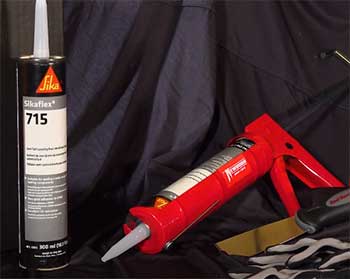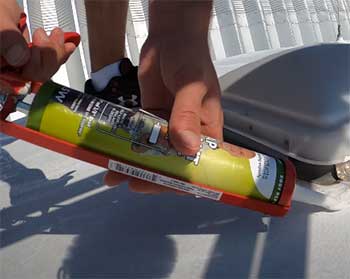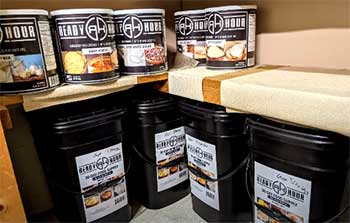Have you tried out Sikaflex 715 or Dicor on your RV roof?
If not, you are certainly missing out!
The best sealants not only provide excellent resistance to extreme outdoor elements but also extend the life of your roof. That said, you should know the features to look at before getting one.
Check out this!
Sikaflex offers a one-year warranty, while Dicor provides a limited lifetime warranty. Sikaflex is made of silane-terminated polymer, whereas Dicor is made of petroleum distillate.
Sounds good so far? And yet we haven’t even gotten to the best part. Read on!
A Brief Comparison Table
| Sealant Description | Sikaflex 715 | Dicor |
| Material Used | Silane-terminated polymer | Petroleum distillate |
| Durability | Six to nine months | Twenty years |
| Curing Period | Two to five days | Thirty days |
| Drying effect | Dries like rubber | It dries like a putty |
| VOC content | Low | None |
| Surfaces To Use On | Flat or nearly flat areas | Horizontal surfaces |
| Cost | $13 to $23 | $39-$60 |
| Roofing Components | EPDM, Aluminum, Phosphate, Chromate, Anodized metal, Zinc-plated steel | Aluminum, Plastic, Vinyl, Wood, Fiberglass, EPDM, TPO, Mortar, Concrete, Galvanized metal |
| Warranty Term | One year | Limited lifetime |
Key Differences Between Sikaflex And Dicor Sealants
- Material Used

Sikaflex 715 is made of silane-terminated polymer material, which contains a compound that entirely cures while exhibiting exceptional adhesive features.
This one-component substance gives the sealant an extra high UV resistance through its elasticity and solidity.
On the contrary, Dicor is made of petroleum distillate, significantly reducing the curing period.
When the lap sealant cures, the distillate evaporates, preventing permanent damage to your roof.
Also Read: Alternatives To Automotive Seam Sealer.
- Durability
Are you looking for a durable sealant that can protect your roof?
Look no further! Sikaflex 715 lasts between six to nine months. I know! You expected a longer time frame than that. But on the bright side, the sealant is super easy to apply and takes little time to cure.
On the other hand, Dicor can last you up to twenty years after application. But of course, this depends on the environmental conditions of your RV and the maintenance you give the sealant.
- Drying Effect
After applying Sikaflex 715, it dries and stretches more like rubber. And on top of that, you can paint the surface if you wish.
Inversely, Dicor lap sealant dries off like putty. If you stretch it too much, it might break. Just a heads-up!
- VOC content
Sikaflex 715 has low volatile organic compounds in the solution, which encompasses a series of chemicals that are emitted as gas and harm health, especially if breathed in.
On the other hand, Dicor has zero VOC content. Therefore, there is a reduced risk of health damage with this sealant.
- Surfaces To Use On
Full disclosure: never use Sikaflex 715 on a raised surface. The sealer is meant for flat or nearly flat surfaces so that it can flow uniformly in all directions.
Inversely, Dicor works most efficiently on horizontal surfaces. Don’t use the product on vertical surfaces to prevent running and creating a mess.
- Cost
You can get yourself Sikaflex 715 for $13. However, if you want another version with more impact, you have to spare $23. On the flip side, Dicor lap sealant costs between $39 and $60.
So, where do you lie? Do you prefer a more durable product with significant long-term effects or an affordable sealer to serve you now?
Also Read: Differences Between RV Armor And FlexArmor RV Roof.
- Curing Period

I understand! Waiting too long for the roof protector to cure can be tiresome.
So, guess what! I have the perfect solution for you.
With Sikaflex 715, you only need to spare two to five days, and the sealant will completely dry up.
Moreover, if you are in a scenario where you can’t afford to wait for an extended time, this is the product for you.
In contrast, Dicor takes at least 30 days to cure entirely, and you can comfortably take your vehicle on a trip. If you’re wondering how long it takes to be waterproof, note that it’s just four hours.
- Roofing Components
Sikaflex 715 works like magic on materials such as aluminum, phosphate, chromate, zinc-plated steel, anodized metal, and EPDM.
On the contrary, Dicor works best on fiberglass, wood, plastic, vinyl, aluminum, EPDM, TPO, mortar, concrete, and galvanized metal. It all depends on your RV roof’s material; you can pick an adhesive of your choice.
- Warranty Term
Warranty is a crucial and significant factor in a product. You purchase a product, and who knows? It might have defects, and a warranty comes in handy. Sikaflex guarantees you one year of defect-free sealant and artistry.
On the other hand, Dicor provides a limited lifetime warranty. The manufacturer takes liability for any defect in the product and the craft. However, it only covers if you followed all the instructions upon application.
Which Sealant Is Better For Your RV?
After having this detailed discussion, I’m sure you have a rough or clear idea of which sealant you’d go for. What are your needs and preferences?
Sikaflex 715 is pocket friendly, requires minimal time to cure fully, and is best for flat surfaces. Contrarily, Dicor has excellent longevity, zero VOC components, offers a limited lifetime warranty, and works on more roofing materials.
Also Read: Differences Between 3M 4200 And 5200 Sealants.
Frequently Asked Questions (FAQ)
TremPro 644 silicon sealant has the most comparison with Dicor. Both are efficient in the installation of RV and roof vents. Moreover, both products work like a charm with rubber-like materials like vinyl, fiberglass, and wood.
Sikaflex 715 is the best and the most convenient to adopt on an RV roof, and here’s why. It creates a highly durable, long-lasting, and excellent resistance to cracks and other components.
The environment is the primary determinant of the lasting period. Nonetheless, with proper maintenance, Dicor roof sealant should last 20 years.
First, apply a bead of the sealant and allow it to flow uniformly in all directions. Afterward, let it settle for about 45 minutes, and the curing process will be completed within two to five days.
Final Thoughts
What did you think about the Sikaflex 715 and Dicor comparison? Did any of the sealants win your heart? I’m positive you already have one in mind that you can’t wait to get your hands on.
If durability doesn’t matter much and you want an affordable adhesive that can cure quickly, Sikaflex 715 has the upper hand. But if you’re looking for excellent durability, VOC-free sealer, a better warranty option, and are okay with paying more, Dicor wins by a mile!



a lot of your information here is incorrect, especially about the durability of Sika715. Sika715 has a lifetime warranty covering the life of the membrane. I am not sure where you got your information, but if you would like to give me a call email me at the email I provided below and we can discuss in depth the benefits and drawbacks of Sika vs. other brands.